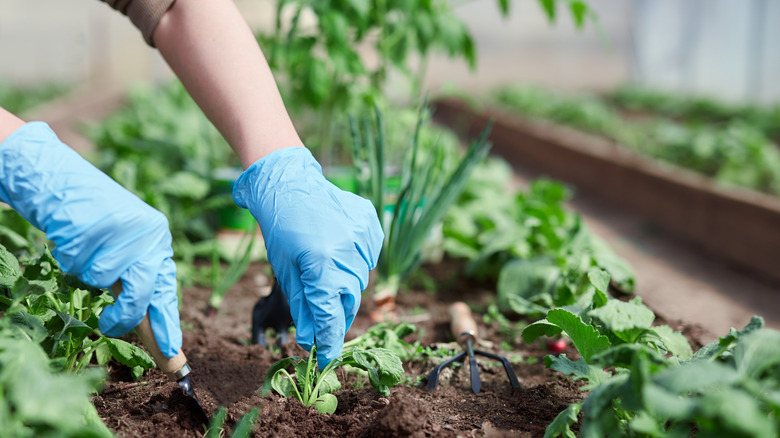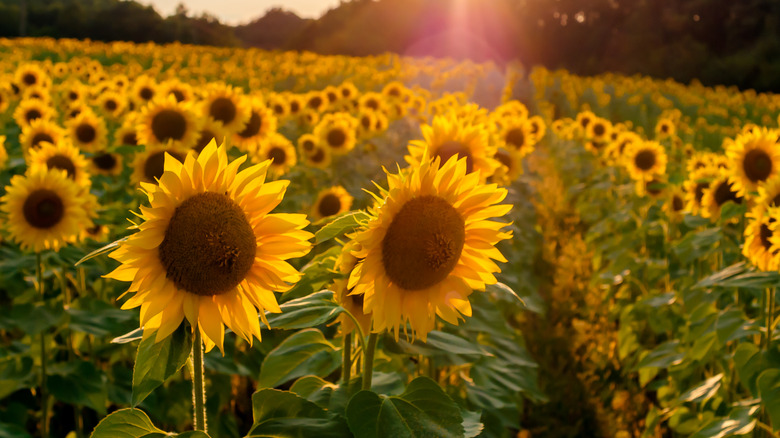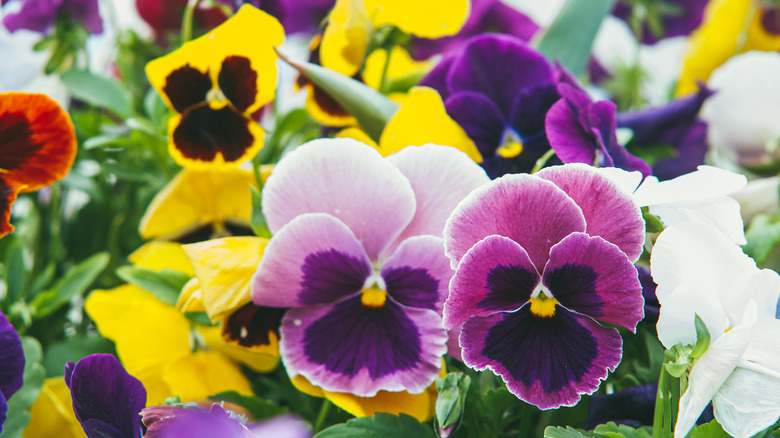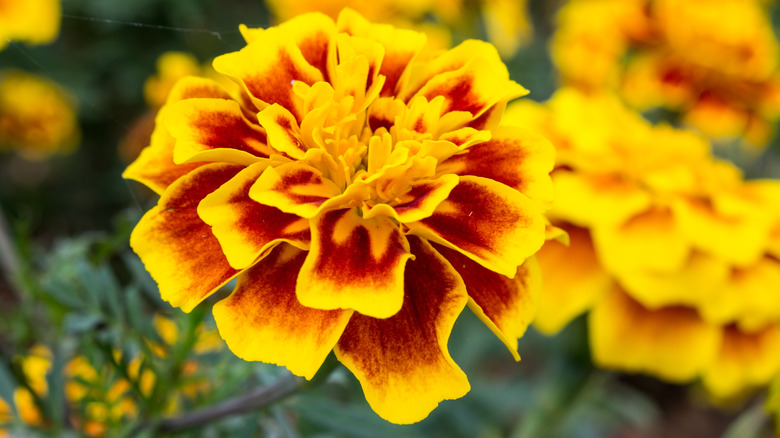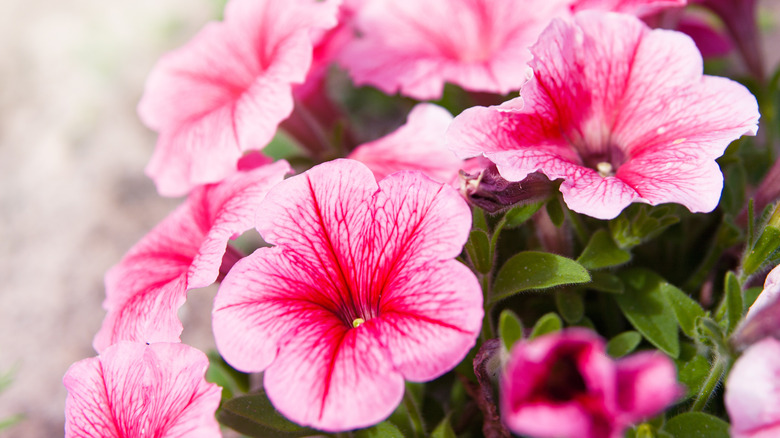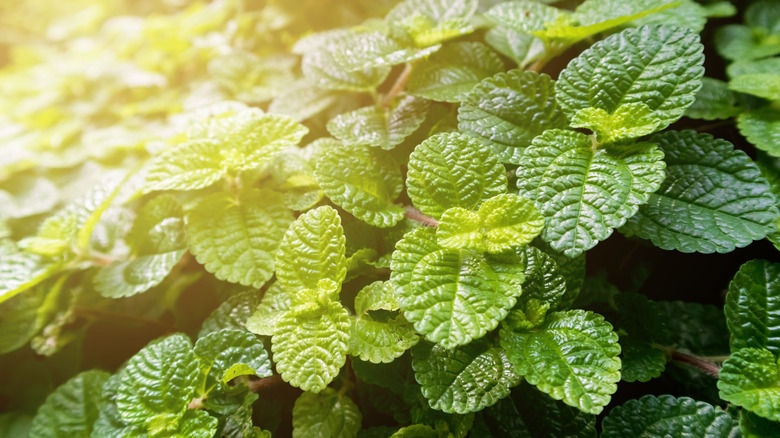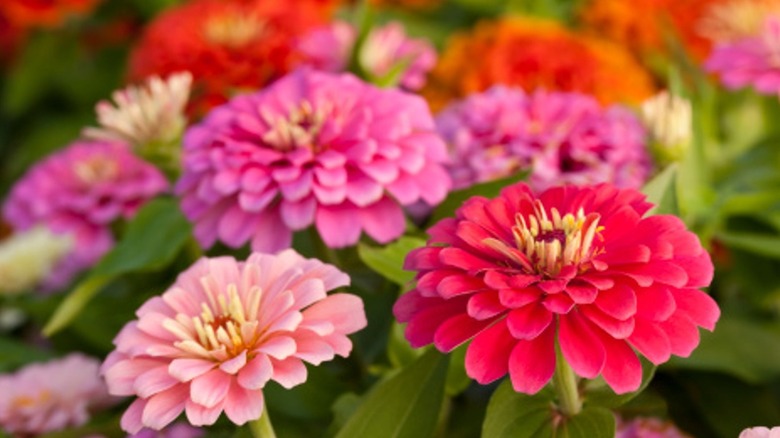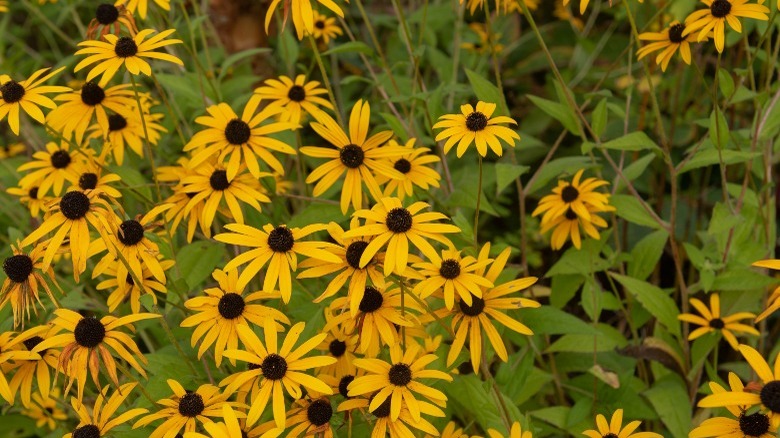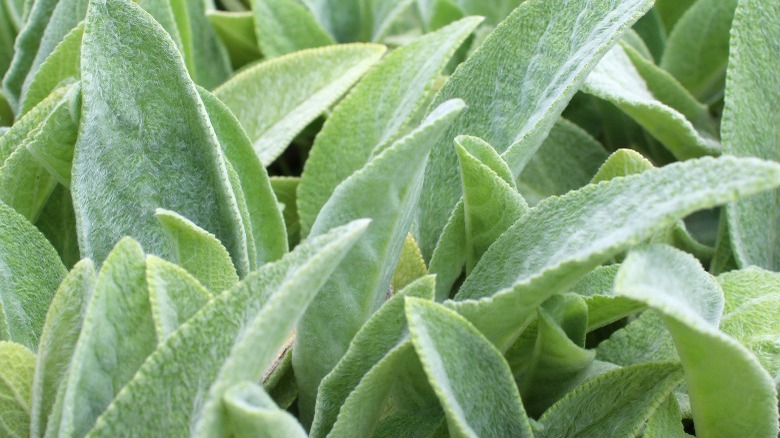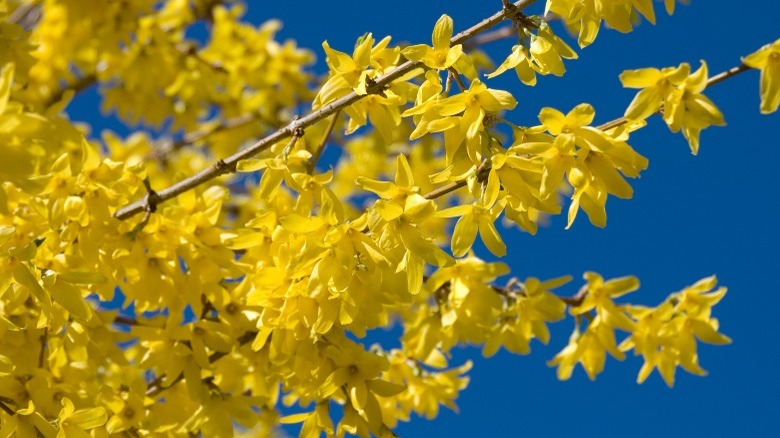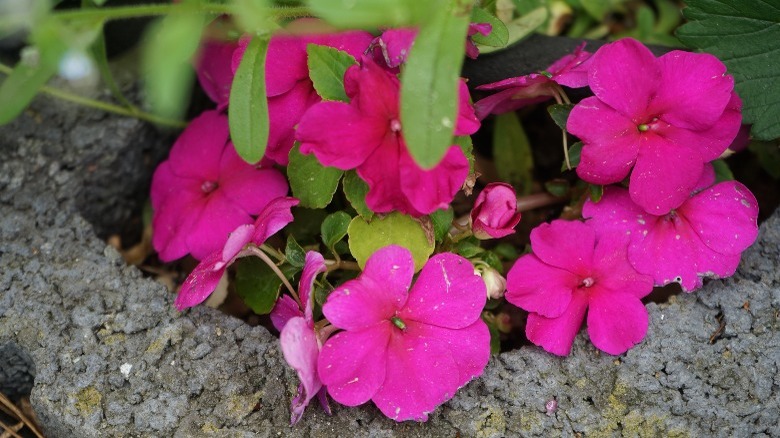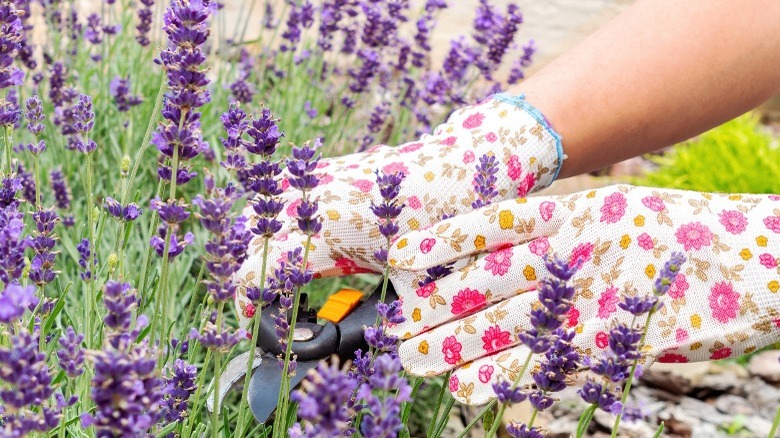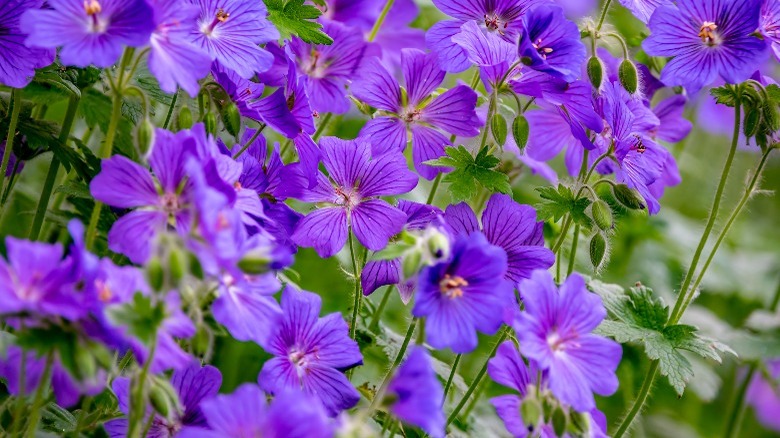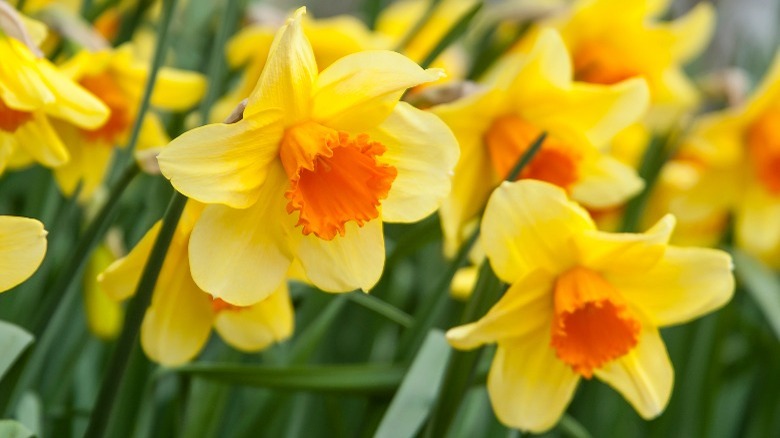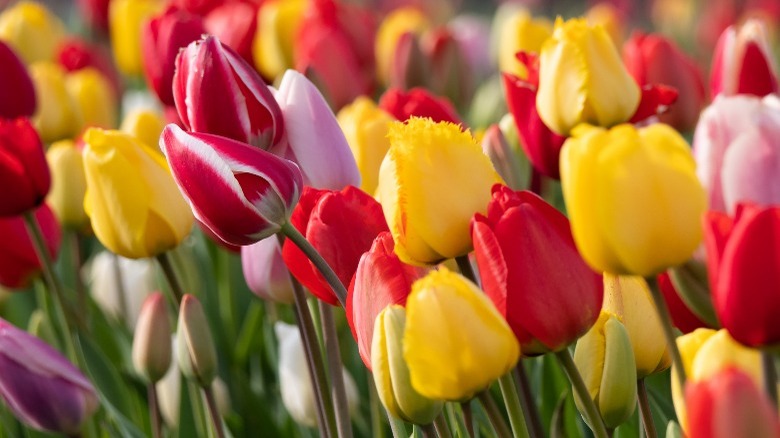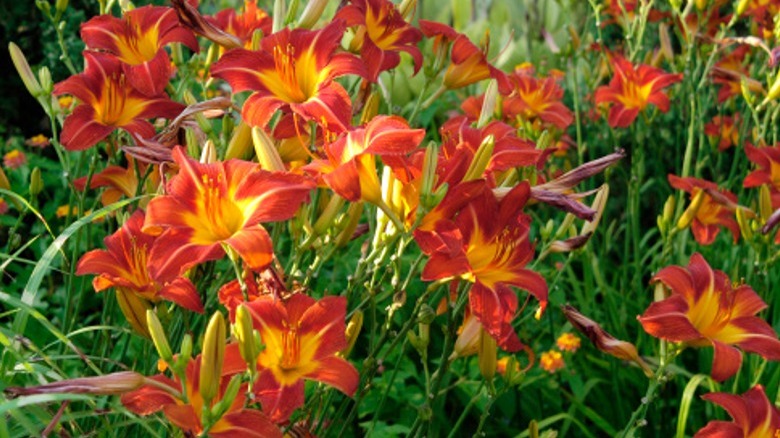The Easiest Plants To Grow For Beginner Gardeners
In case you missed it, plants have become a huge trend in recent years, with newbies buying their first houseplants to tend as well as experimenting with gardening for the first time — and for good reason. The hobby allows you to connect with nature, serves as an outlet for stress relief, and can be immensely rewarding as you watch your plants grow and flourish (and maybe even produce food).
Whether you live on the fifth floor of an apartment building or have a sprawling yard with unlimited space, you can garden anywhere. Before you begin, brush up on what you need to know about planting a garden. But keep this in mind: Gardening is all about trial and error — and being able to laugh it off when Mother Nature throws your plans out the window.
Even if your thumb isn't so green, load up your bags of potting soil or gardening soil, and gather your essential gardening tools: We've rounded up fifteen of the easiest plants to grow for beginner gardeners. They're sure to make your first season of planting a successful one.
1. Sunflowers
The cheerful sunflower is unmistakable. Despite their large heads and towering stature, don't be intimidated: They're actually quite forgiving for novice gardeners. Mental Floss suggests waiting until the threat of frost has passed and choosing a location that gets plenty of direct sunlight throughout the day. Then, plant the seeds in one-inch holes. You'll want to space them about six inches apart, as you don't want to risk overcrowding once their growth takes off. Be sure to check the seed packet label for any instructions specific to the variety you choose since some types need to be spaced much farther apart.
Give the seeds a good drink of water after planting, but be careful not to overwater once the sunflowers are established, which could ruin your chances of success. According to Mental Floss, these hardy flowers do well even in poor soil, which means you don't need to worry about fertilizing them. You'll get to enjoy their bright faces throughout the hottest days of summer, and their seeds make a delicious snack, so you can't go wrong.
2. Pansies
If you live in a part of the country where temperatures can fluctuate drastically throughout the course of one season, pansies are the perfect flower for you. You'll often see them sold in garden centers in the fall and spring because these hardy flowers are resilient enough to withstand winter weather. HGTV recommends adding a layer of mulch around your pansies to protect them through the cold months.
When you're ready to plant them in the spring (or fall), pick a spot that has plenty of sunshine and rich soil that drains well — you don't want the roots to get soggy. The flowers do need regular watering, but the trick is not to overwater them. Certain varieties can thrive in partial shade, so be sure to read the label on the type you choose. An added plus? Pansies attract butterflies, according to Garden Design. So not only will you get to enjoy their colorful blooms, but you'll also be treated to the beautiful pollinators that stop by for a visit.
3. Marigolds
Whether you buy ready-to-plant marigolds or opt to start them from seeds, this annual will go easy on you regardless. The flowers bloom in shades of red, orange, and yellow. Some varieties are tall and leggy, while others remain short and compact. Choose whichever suits your garden aesthetic. If you decide to grow them from seeds, Mental Floss says to wait until after the last frost and plant them in moist, well-draining soil. Spacing varies by the type of marigold you choose, so consult the instructions on the seed packet.
While marigolds are low-maintenance and long-blooming, they have an additional perk: protecting tomatoes. According to Modern Farmer, marigolds release limonene, a gaseous chemical. It acts as a natural deterrent of pests like whiteflies that wreak havoc on tomato plants. "Aside from looking nice, using another plant as a pest repellent is a far better solution than a pesticide, which kills beneficial insects as well as harmful ones," notes Modern Farmer. The flowers are easy to grow, last all summer, and help keep your tomatoes healthy. What more could you want?
4. Petunias
Known for their trumpet-like shape and nearly limitless array of colors, petunias are a terrific option for an easy flower that packs a major visual punch. You can find compact varieties or trailing, striped or speckled blooms — there's even a black shade of petunia if you want to amp up the drama in your garden. Who knew that a flower with such a dizzying array of options could be so easy to grow? According to Garden Design, you'll get the most "prolific" flowers if you plant in full sun with fertile soil and good drainage.
Petunias do require regular watering because their root systems are shallow, but, if the leaves on the plant begin to turn yellow, that's a sign you're watering too much. In order to keep them blooming all summer long, some petunia varieties need to be deadheaded. This means pinching off the spent blooms once they're shriveled up or crunchy. As always, check the label to see if the variety you've chosen will benefit from some deadheading maintenance.
5. Mint
If you're looking for something easy to grow that's also delicious in cocktails and cooking, look no further than mint. This tasty herb is actually a perennial, so it will return each year if you plant it in the ground. Better Homes & Gardens warns that mint can overtake your garden since it spreads with such ease. Keep it trimmed to prevent spreading, or just plant your mint in pots.
Either way, mint does well in full sun to partial shade. It likes damp, well-draining soil, which means it'll need some extra watering if your area goes through a dry spell. When it comes to pruning, Better Homes & Gardens advises to "remove flowers as they appear, and pinch back the stems to encourage shorter, bushier growth. In fall, cut the plants to the ground after a hard frost has withered their stems."
There are many varieties of mint — including classics like spearmint and peppermint as well as interesting varieties like chocolate mint and apple mint — so you can choose one that's perfectly tailored for your needs. Whether you muddle the leaves into a cocktail or dry them to make tea, the possibilities are endless and delicious.
6. Zinnias
These annuals have an almost daisy-like appearance and come in bright colors like yellow, pink, purple, and red. They range from 1 to 4 feet tall and each single, double, or semi-double flower sits atop a thick stem. And aside from being easy to grow, zinnias attract butterflies and hummingbirds and make lovely flower bouquets that can last about a week and a half in vases.
Zinnias can be grown from seeds or you can buy young plants, but only plant them after the threat of frost has passed. Choose a spot with well-draining soil and plant the seeds a few inches apart as those can be thinned out later. Young seedlings can be planted with 8 to 18 inches of space in between. Zinnias aren't that picky about soil and thrive in clay, sandy, loamy, or chalky soils. They should be planted in areas with six hours of sun per day and only need to be watered about once a week. Treat the soil with compost before planting, and mulch the plants once they're established. Aside from that, trim off the spent blooms regularly to increase flower production.
7. Black-eyed Susans
Smaller-sized cousins to sunflowers, these are also easy to grow for inexperienced gardeners. The perennial wildflowers sport bright yellow petals, prominent black seed heads, and blooms from summertime until early autumn. They can be planted in mid-spring or fall in spots that get full sun. Black-eyed Susans are drought-tolerant once established, but they do appreciate about an inch of water per week.
The seeds can be sowed into the garden when the outdoor temperatures are over 70 degrees. They can be scattered over the soil, covered with a light layer of dirt, and watered. Plant dwarf seedlings 6 to 12 inches apart and larger ones from 18 to 30 inches apart. Black-eyes Susans stretch up to 36 inches tall, are resistant to diseases and pests, and make lovely bouquets. They are known to spread throughout gardens because they have aggressive root systems and are self-seeding. To keep them under control, just thin them out every four or five years.
8. Lamb's Ear
This next perennial is known best for its velvety-soft leaves but it also produces very small purple flowers in the summertime. Lamb's ear can easily be grown into a handsome silvery-gray ground cover that thrives in full sun to partial shade. It can grow to be 1½ feet tall at the most and each plant can spread equally as wide. The flowers grow in spikes, but some gardeners remove them to direct more energy to leaf production.
Place lamb's ear starter plants into the soil in the spring, about 12 to 18 inches apart. These hardy favorites prefer dry to medium soil and are drought-tolerant. They don't need fertilizer to grow either, and rabbits and deer don't like them. These plants only need to be watered when the soil is very dry and deadheading isn't necessary. Typically, the only real problem comes when these plants are overwatered, and the symptoms of this would include rotted or wilted leaves.
9. Forsythia
Perfect for adding height and cheery color to gardens, the forsythia's bright yellow flowers are often one of the first signs of spring. These early-blooming, tall shrubs can grow up to 8 feet high and 12 feet wide and require little attention to thrive. The prolific flowers make their presence known in the late winter once the soil temperature reaches 55 degrees Fahrenheit. They are showy enough to outshine their bluish-green summertime foliage until the leaves turn a pretty deep purple as temperatures drop in autumn.
The forsythia does best in full sun and should be planted in evenly moist soil. These shrubs can handle drought conditions once they are established, but once-weekly waterings are preferred. They can benefit from a 10-10-10 fertilizer application twice a year in the spring and summer, after the first year of growth. These shrubs are not completely upright, and the shape can often be described as curved or weeping.
10. Impatiens
Popular with rookie gardeners, impatiens can be planted in the late spring and do well in shaded areas as long as the soil is slightly acidic. Its flowers come in red, orange, pink, purple, and other colors, and bloom for months on end. Classified as a tender perennial, they can survive warm winters but not frost.
Most people buy young impatiens instead of seeds, but always keep the former watered until they get planted. It's good to amend the soil with some compost before planting, and then put the plants into holes dug 2 to 4 inches apart. Impatiens tend to grow into one another, which can be quite attractive. Keep the soil in good shape with weekly waterings but don't allow puddles of water to form. Fertilizer is not usually needed but impatiens grown in containers can benefit from it. These plants can grow up to 2 feet high and wide and are not known to have any significant pest problems.
11. Lavender
Lavender does well in containers, rock gardens, paths, and herb gardens, making it a great plant to easily add anywhere in your yard. Plus, besides looking elegant, it has a wonderful smell. It should be planted in the spring in a sunny area that has sandy, well-draining soil. Some gardeners also add builder's sand to the dirt before planting to stave off excess moisture but that isn't always necessary. To plant lavender, amend the soil with compost and dig out holes that are 12 to 18 inches apart.
As they are somewhat drought-tolerant, lavender only needs a drink when the top 2 inches of soil seem dry. Expect the flowers to come out in the summertime and cut the plants back lightly each spring. The important thing to remember with this perennial is to give it enough air circulation because excess heat and moisture can lead to fungus. Lavender is known to reemerge larger each year, so it's a good plant to practice your emerging pruning and shaping skills.
12. Geraniums
This easy-going, flowering annual is versatile enough to thrive in hanging baskets, window boxes, and gardens. It loves full sunlight but is hardy enough to recover in partial shade should it get sunburned. The fragrant flowers come in white, pink, orange, red, or purple, and the plants never need to be pruned. The leaves can also be colorful, in shades like green, red, and bronze. There are even ones with patterns.
The size of a geranium size depends on the variety. The most common species range from 2 to 4 feet tall and wide, while ivy geraniums can spread out up to 4 feet. Plant the seedlings 6 to 24 inches apart in fertile, well-draining soil. Water them consistently, allowing the soil to dry out partially but not completely in between. The plants can also benefit from a balanced liquid fertilizer applied once a month during the growing season. The ASPCA warns that geraniums are toxic to cats and dogs though, so some pet owners may want to choose other beginner plants for their gardens.
13. Daffodils
There's no reason to be afraid of growing plants that sprout from flower bulbs and they have the bonus of returning year after year. Daffodils fall into this category and can be first planted in gardens in the fall when it's still about 60 degrees out. The roots develop when it's cold outside and the foliage pokes out in the spring. The familiar white, bright yellow, orange, or pink flowers have six petals and a cup-shaped part in the middle. Choose one of the standard varieties to get the largest blooms.
Daffodils need full sun or partial shade and fertile soil. When you find an ideal home, dig out planting holes 4 to 8 inches deep and 4 to 6 inches apart. Each bulb should be deposited with its pointy end up and then covered with soil. Then it can be watered thoroughly and after that, about 1 inch per week. Once the flowers come out in the spring, they should last for six weeks up to six months. Remain hands off until those and the foliage have wilted completely because the plant needs that energy for the next growing season. With proper care, the bulbs should produce daffodils for years.
14. Tulips
Stress-free and cup-like in appearance, tulips also emerge from bulbs planted in the ground during the fall. There are approximately 80 species that can be found in every color of the rainbow except for blue. Others can be varicolored or feature double flowers.
The planting process and maintenance is about the same as with daffodils but some gardeners like fertilizing the bulbs once they are planted and again at the start of spring. A layer of 2 to 3 inches of mulch on top of the soil can also aid with moisture retention. But with tulips, snip off the wilted blooms sooner or seeds will start to form. They do fine in average kinds of garden soil but if the temperatures plummet, it's a good idea to cover the planting area with compost or leaves. And if the soil gets overly wet, try poking deep holes into the soil about 4 inches away from the base. Then, add a bit of compost or sand to help with drainage.
15. Daylilies
This tough perennial plant is not a true lily because it doesn't grow from a bulb but that's not the most interesting thing about it. The daylily can have up to six stems that produce as many as 15 buds apiece. Each flower lives for just one day — hence the name. But since it features so many buds, the plant always looks like it's in bloom. The vibrant flowers come in different shapes and colors like red, orange, and purple and the resilient plant is perfect for a low-maintenance gardening routine.
A daylily planting site should get a minimum of six hours of daily sun, with moist soil. The roots should be soaked in cool water for half an hour before planting to rehydrate them. Dig a hole about 12 inches deep, lower in the plant into the center of the hole, and spread its roots out before filling in the hole with dirt. Give daylilies 18 to 24 inches of space to grow, mulch the bases, and water afterward and every day for a week or so if it hasn't rained. Remove spent blooms and yellowed leaves during the season to promote more growth.
